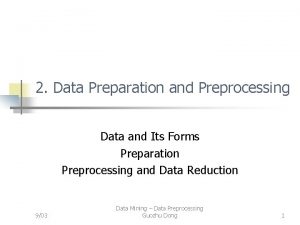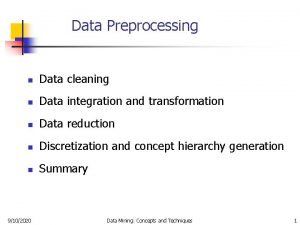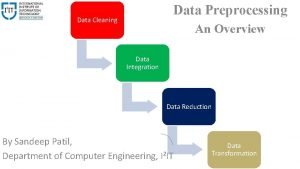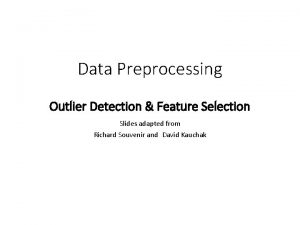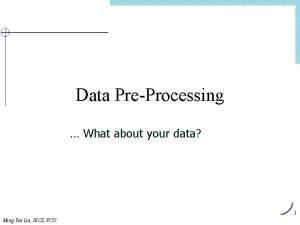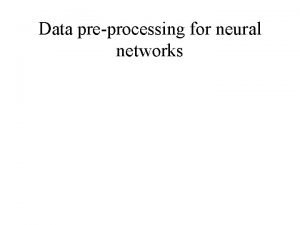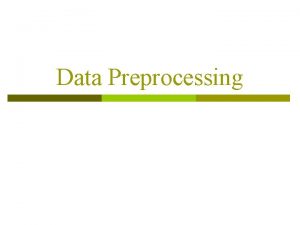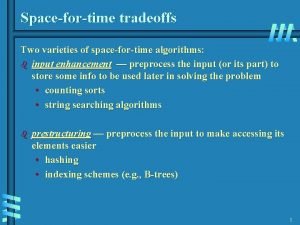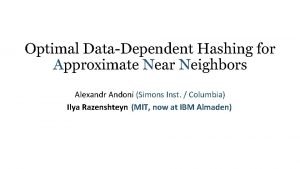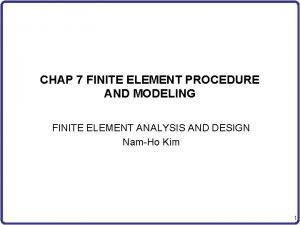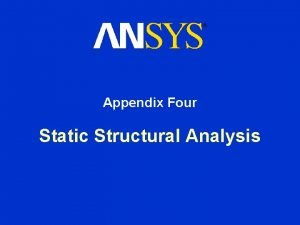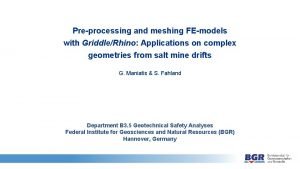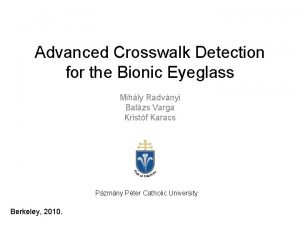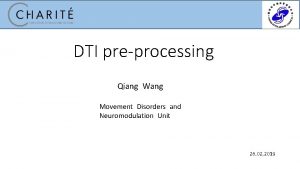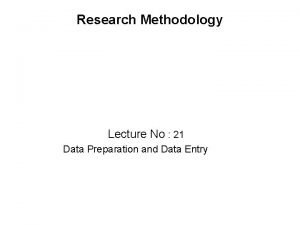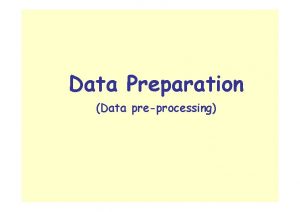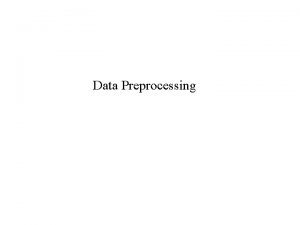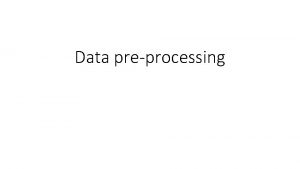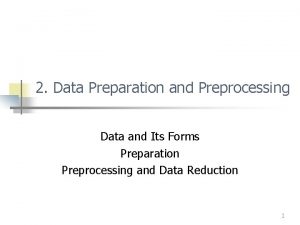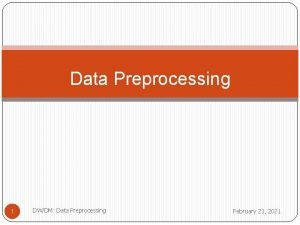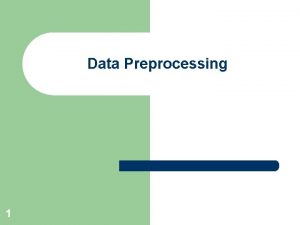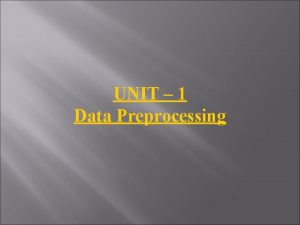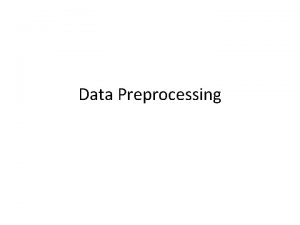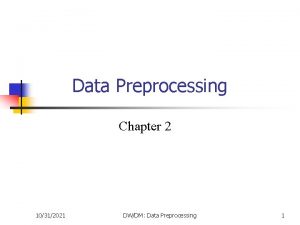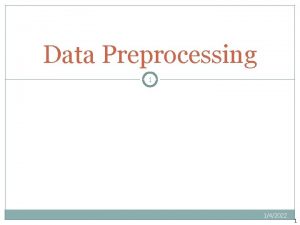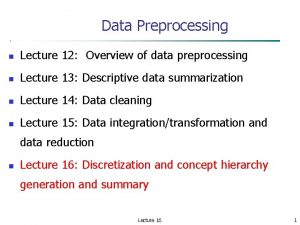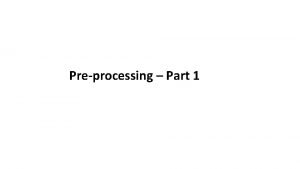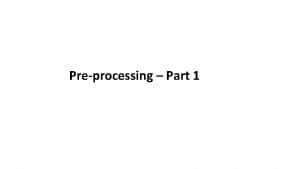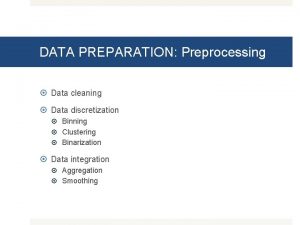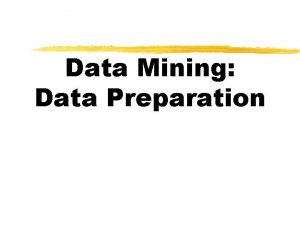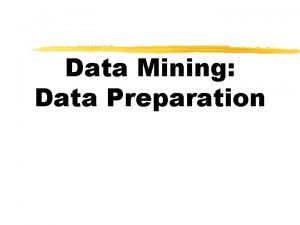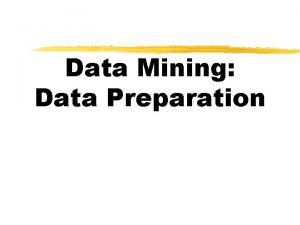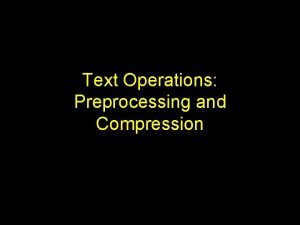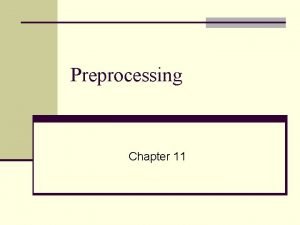2 Data Preparation and Preprocessing Data and Its

























- Slides: 25

2. Data Preparation and Preprocessing Data and Its Forms Preparation Preprocessing and Data Reduction 9/03 Data Mining – Data Preprocessing Guozhu Dong 1

Data Types and Forms n n Attribute-vector data: Data types n numeric, categorical (see the hierarchy for their relationship) n n static, dynamic (temporal) Other data forms n n n 9/03 distributed data text, Web, meta data images, audio/video Data Mining – Data Preprocessing Guozhu Dong 2

Data Preparation n n n An important & time consuming task in KDD High dimensional data (20, 1000, …) Huge size (volume) data Missing data Outliers Erroneous data (inconsistent, mis-recorded, distorted) Raw data 9/03 Data Mining – Data Preprocessing Guozhu Dong 3

Data Preparation Methods n n Data annotation Data normalization n n Dealing with sequential or temporal data n n Examples: image pixels, age Transform to tabular form Removing outliers n 9/03 Different types Data Mining – Data Preprocessing Guozhu Dong 4

Normalization n Decimal scaling n n n Min-max normalization into new max/min range: n n n v’(i) = v(i)/10 k for the smallest k such that max(|v’(i)|)<1. For the range between -991 and 99, 10 k is 1000, -991 -. 991 v’ = (v - min. A)/(max. A - min. A) * (new_max. A - new_min. A) + new_min. A v = 73600 in [12000, 98000] v’= 0. 716 in [0, 1] (new range) Zero-mean normalization: n n n 9/03 v’ = (v - mean. A) / std_dev. A (1, 2, 3), mean and std_dev are 2 and 1, (-1, 0, 1) If mean. Income = 54000 and std_dev. Income = 16000, then v = 73600 1. 225 Data Mining – Data Preprocessing Guozhu Dong 5

Temporal Data n The goal is to forecast t(n+1) from previous values n n X = {t(1), t(2), …, t(n)} An example with two features and widow size 3 n How to determine the window size? Time A B Inst A(n-2) A(n-1) A(n) B(n-2) B(n-1) B(n) 1 7 215 2 10 211 1 7 10 6 215 211 214 3 6 214 2 10 6 11 214 221 4 11 221 5 12 210 3 6 11 12 214 221 210 6 14 218 4 11 12 14 221 210 218 9/03 Data Mining – Data Preprocessing Guozhu Dong 6

Outlier Removal n n Outlier: Data points inconsistent with the majority of data Different outliers n n n Valid: CEO’s salary, Noisy: One’s age = 200, widely deviated points Removal methods n n n 9/03 Clustering Curve-fitting Hypothesis-testing with a given model Data Mining – Data Preprocessing Guozhu Dong 7

Data Preprocessing n Data cleaning n n missing data noisy data inconsistent data Data reduction n 9/03 Dimensionality reduction Instance selection Value discretization Data Mining – Data Preprocessing Guozhu Dong 8

Missing Data n Many types of missing data n n not measured not applicable wrongly placed, and ? Some methods n n 9/03 leave as is ignore/remove the instance with missing value manual fix (assign a value for implicit meaning) statistical methods (majority, most likely, mean, nearest neighbor, …) Data Mining – Data Preprocessing Guozhu Dong 9

Noisy Data n Noise: Random error or variance in a measured variable n n n Noise is normally a minority in the data set n n inconsistent values for features or classes (processing) measuring errors (source) Why? Removing noise n n n 9/03 Clustering/merging Smoothing (rounding, averaging within a window) Outlier detection (deviation-based or distance-based) Data Mining – Data Preprocessing Guozhu Dong 10

Inconsistent Data n n Inconsistent with our models or common sense Examples n n n 9/03 The same name occurs as different ones in an application Different names appear the same (Dennis vs. Denis) Inappropriate values (Male-Pregnant, negative age) One bank’s database shows that 5% of its customers were born on 11/11/11 … Data Mining – Data Preprocessing Guozhu Dong 11

Dimensionality Reduction n Feature selection n n select m from n features, m≤ n remove irrelevant, redundant features + saving in search space Feature transformation (PCA) n n n 9/03 form new features (a) in a new domain from original features (f) many uses, but it does not reduce the original dimensionality often used in visualization of data Data Mining – Data Preprocessing Guozhu Dong 12

Feature Selection n Problem illustration n n Full set Empty set Enumeration Search n n 9/03 Exhaustive/Complete (Enumeration/B&B) Heuristic (Sequential forward/backward) Stochastic (generate/evaluate) Individual features or subsets generation/evaluation Data Mining – Data Preprocessing Guozhu Dong 13

Feature Selection (2) n Goodness metrics n n n Dependency: dependence on classes Distance: separating classes Information: entropy Consistency: 1 - #inconsistencies/N n Example: (F 1, F 2, F 3) and (F 1, F 3) n Both sets have 2/6 inconsistency rate Accuracy (classifier based): 1 - error. Rate F 1 F 2 F 3 C 0 0 1 1 0 0 0 1 0 0 0 Their comparisons n 9/03 Time complexity, number of features, removing redundancy Data Mining – Data Preprocessing Guozhu Dong 14

Feature Selection (3) n Filter vs. Wrapper Model n n Pros and cons n time n generality n performance such as accuracy Stopping criteria n n 9/03 thresholding (number of iterations, some accuracy, …) anytime algorithms n providing approximate solutions n solutions improve over time Data Mining – Data Preprocessing Guozhu Dong 15

Feature Selection (Examples) n SFS using consistency (c. Rate) n n n LVF using consistency (c. Rate) 1 2 3 n n select 1 from n, then 1 from n-1, n-2, … features increase the number of selected features until prespecified c. Rate is reached. randomly generate a subset S from the full set if it satisfies prespecified c. Rate, keep S with min #S go back to 1 until a stopping criterion is met LVF is an any time algorithm Many other algorithms: SBS, B&B, . . . 9/03 Data Mining – Data Preprocessing Guozhu Dong 16

Transformation: PCA n D’ = DA, D is meancentered, (N n) n Calculate and rank eigenvalues of the covariance matrix m E-values Diff Prop Cumu 1 2. 91082 1. 98960 0. 72771 0. 72770 2 0. 92122 0. 77387 0. 23031 0. 95801 3 0. 14735 0. 12675 0. 03684 0. 99485 4 0. 02061 0. 00515 1. 00000 n r = ( i ) / ( i ) i=1 n n n i=1 Select largest ’s such that r > threshold (e. g. , . 95) corresponding eigenvectors form A (n m) Example of Iris data 9/03 V 1 V 2 V 3 V 4 F 1 0. 522372 0. 372318 -. 721017 -. 261996 F 2 -. 263355 0. 925556 0. 242033 0. 124135 F 3 0. 581254 0. 021095 0. 140892 0. 801154 F 4 0. 565611 0. 065416 0. 633801 -. 523546 Data Mining – Data Preprocessing Guozhu Dong 17

Instance Selection n Sampling methods n n n random sampling stratified sampling Search-based methods n n 9/03 Representatives Prototypes Sufficient statistics (N, mean, std. Dev) Support vectors Data Mining – Data Preprocessing Guozhu Dong 18

Value Discretization n Binning methods n n n Equal-width Equal-frequency Class information is not used Entropy-based Chi. Merge n 9/03 Chi 2 Data Mining – Data Preprocessing Guozhu Dong 19

Binning n Attribute values (for one attribute e. g. , age): n n Equi-width binning – for bin width of e. g. , 10: n n n Bin 1: 0, 4 [-, 10) bin Bin 2: 12, 16, 18 [10, 20) bin Bin 3: 24, 26, 28 [20, +) bin We use – to denote negative infinity, + for positive infinity Equi-frequency binning – for bin density of e. g. , 3: n n 0, 4, 12, 16, 18, 24, 26, 28 Bin 1: 0, 4, 12 Bin 2: 16, 18 Bin 3: 24, 26, 28 [-, 14) bin [14, 21) bin [21, +] bin Any problems with the above methods? 9/03 Data Mining – Data Preprocessing Guozhu Dong 20

Entropy-based n Given attribute-value/class pairs: n n Entropy-based binning via binarization: n n (0, P), (4, P), (12, P), (16, N), (18, P), (24, N), (26, N), (28, N) Intuitively, find best split so that the bins are as pure as possible Formally characterized by maximal information gain. Let S denote the above 9 pairs, p=4/9 be fraction of P pairs, and n=5/9 be fraction of N pairs. Entropy(S) = - p log p - n log n. n n 9/03 Smaller entropy – set is relatively pure; smallest is 0. Large entropy – set is mixed. Largest is 1. Data Mining – Data Preprocessing Guozhu Dong 21

Entropy-based (2) n Let v be a possible split. Then S is divided into two sets: n n Information of the split: n n n I(S 1, S 2) = (|S 1|/|S|) Entropy(S 1)+ (|S 2|/|S|) Entropy(S 2) Information gain of the split: n n S 1: value <= v and S 2: value > v Gain(v, S) = Entropy(S) – I(S 1, S 2) Goal: split with maximal information gain. Possible splits: mid points b/w any two consecutive values. n For v=14, I(S 1, S 2) = 0 + 6/9*Entropy(S 2) = 6/9 * 0. 65 = 0. 433 Gain(14, S) = Entropy(S) - 0. 433 n maximum Gain means minimum I. n The best split is found after examining all possible split points. n 9/03 Data Mining – Data Preprocessing Guozhu Dong 22

Chi. Merge and Chi 2 n n n Given attribute-value/class pairs Build a contingency table for every pair of intervals Chi-Squared Test (goodness-of-fit), 2 k 2 = (Aij – i=1 j=1 n Eij)2 / Eij Parameters: df = k-1 and p% level of significance n 9/03 Chi 2 algorithm provides an automatic way to adjust p Data Mining – Data Preprocessing Guozhu Dong C 1 C 2 I-1 A 12 R 1 I-2 A 21 A 22 R 2 C 1 C 2 N F C 12 P 12 N 12 P 16 N 16 P 24 N 23

Summary n Data have many forms n n Raw data need to be prepared and preprocessed for data mining n n n Attribute-vectors: the most common form Data miners have to work on the data provided Domain expertise is important in DPP Data preparation: Normalization, Transformation Data preprocessing: Cleaning and Reduction DPP is a critical and time-consuming task n 9/03 Why? Data Mining – Data Preprocessing Guozhu Dong 24

Bibliography n n 9/03 H. Liu & H. Motoda, 1998. Feature Selection for Knowledge Discovery and Data Mining. Kluwer. M. Kantardzic, 2003. Data Mining - Concepts, Models, Methods, and Algorithms. IEEE and Wiley Inter-Science. H. Liu & H. Motoda, edited, 2001. Instance Selection and Construction for Data Mining. Kluwer. H. Liu, F. Hussain, C. L. Tan, and M. Dash, 2002. Discretization: An Enabling Technique. DMKD 6: 393423. Data Mining – Data Preprocessing Guozhu Dong 25
 Sequential feature selection
Sequential feature selection Data integration in data preprocessing
Data integration in data preprocessing Data integration in data preprocessing
Data integration in data preprocessing Data preprocessing examples
Data preprocessing examples Data pretreatment
Data pretreatment Neural network data preprocessing
Neural network data preprocessing Major tasks in data preprocessing
Major tasks in data preprocessing Password hashing and preprocessing
Password hashing and preprocessing Password hashing and preprocessing
Password hashing and preprocessing Image url to text
Image url to text Document preprocessing
Document preprocessing Image preprocessing
Image preprocessing Image preprocessing
Image preprocessing Preprocessing fem
Preprocessing fem Preprocessing in image processing
Preprocessing in image processing Dti preprocessing
Dti preprocessing Data preparation and basic data analysis
Data preparation and basic data analysis Markku roiha
Markku roiha Bright filled paperweight
Bright filled paperweight Its halloween its halloween the moon is full and bright
Its halloween its halloween the moon is full and bright When a train increases its velocity, its momentum
When a train increases its velocity, its momentum Sunny cloudy windy rainy
Sunny cloudy windy rainy If its square its a sonnet
If its square its a sonnet Its not easy but its worth it
Its not easy but its worth it Field editing in research methodology
Field editing in research methodology Pengertian preparation
Pengertian preparation
